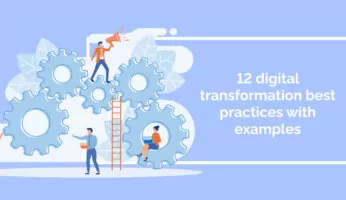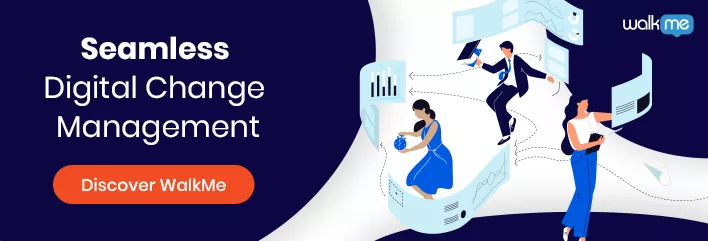
Employee training helps employees learn and develop new skills and stay up-to-date with the latest advances in their field.
Continuous training and growth are critical to the long-term success of your business.
Not only does effective employee training boost productivity, but it also drives up employee engagement. Your employees want to learn, and you want them to be able to do their jobs more efficiently and effectively.
Furthermore, employee training is a critical stage in successful change management. Whether introducing new digital tools or restructuring existing business processes, you need to ensure your employees feel ready to roll with the changes.
If you fail to do so, your employees are more likely to resist change.
In the long run, it’s also cheaper to skill your employees up than it is to hire external specialists. Indeed, providing consistent employee training opportunities is a win-win scenario for you and your employees.
In this article, we’re sharing 16 practical, modern, effective employee training methods you can use today.
Following an established employee training method or using an employee training template will help you create engaging, driven employees and foster a culture of learning and development.
The importance of employee training for digital-first businesses
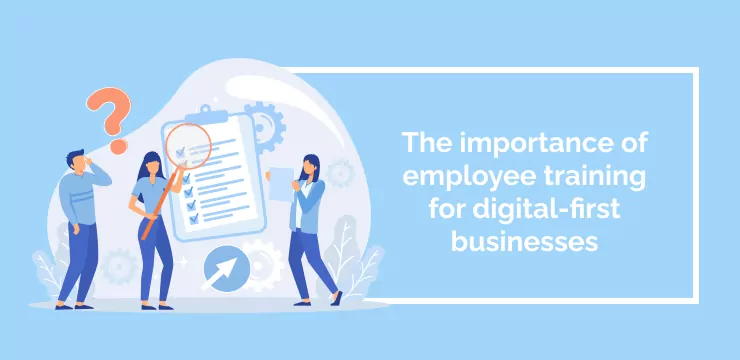
The 2020 Gartner Shifting Skills Survey found that 60% of HR leaders feel pressure from the C-suite to deliver excellent employee training.
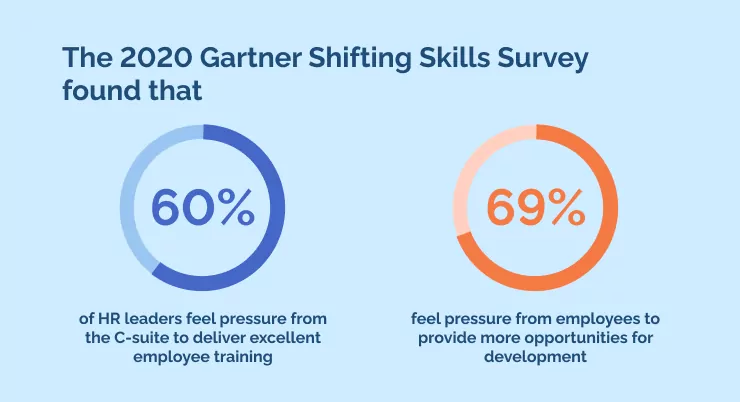
On top of that, the same survey found 69% feel pressure from employees to provide more opportunities for development.
Why does everyone seem to agree that employee training should be a priority?
The same research from Gartner found that in our increasingly digital world, 30% of skills learned on the job become irrelevant within 3 years.

All these stats paint a clear picture.
Success in digital requires constant training if your business is to keep up with the competition.
And as more niche digital tools emerge, so do niche digital skill sets. It’s always cheaper to train employees in these niche specialties than to hire externally.
The 16 best employee training methods for 2023
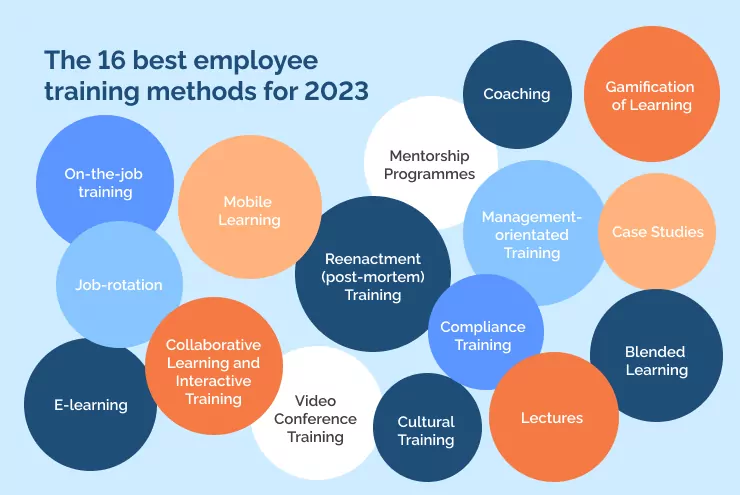
Without further ado, here are 16 training methods every business should know about in 2023.
You may use all of these methods in tandem. You may only use a select handful.
You may find that you use none, but the methods outlined here inspire you to devise better ways to deliver employee training.
However you use them, all the methods listed here are a great place to start.
On-the-job training
Learning on the job gives employees hands-on training that ensures they can handle the reality of their role.
Employees see first-hand the challenges they face, the skills they need, and they quickly receive the support to make a difference.
This training method can work exceptionally well, especially in technical roles. There are always nuances to real-life work that training scenarios can’t cover. On-the-job training addresses that problem.
But on-the-job training isn’t always an option. For example, if you plan to go live with a big software implementation, there’s no way to practice with the entire system before the big day.
Also, diving straight into on-the-job training can be stressful for employees who don’t feel prepared.
Job-rotation
Giving staff a job rotation experience is a fantastic way to develop a comprehensive skillset within your organization.
It’s especially great for showing early career staff the various paths they could develop in the long term.
It’s often used in medical training and management training schemes. Training through job rotation is most likely to occur as part of an employee onboarding process— in which hires begin working in one environment before moving to others.
There’s no better way of helping entry-level employees get to grips with a complex operation’s moving parts.
E-learning
There are many types of E-learning training methods. The term can encompass online training, in-app guidance, training videos, and more.
E-learning is a popular method of training because it’s so efficient. That said, it might not always be inspiring.
Employees can work through e-learning at their own pace, asynchronously, and tracking their progress is easy. But it’s generally less engaging than in-person training.
E-learning is most useful when the learning goal includes some aspect of digital literacy. For example, when introducing new software, everyone in the business needs to know how to use it.
Mobile Learning
This is a more specific type of e-Learning in which employees access training materials through their mobile devices.
Most e-learning content is either inaccessible by mobile or not optimized for a mobile interface.
M-Learning is accessible, entertaining, and efficient. It lets employees learn in a flexible and convenient manner.
It may seem unnecessary when e-learning exists, but you may find that mobile learning provides a better digital experience for your employees.
Coaching
In the right circumstances, individual coaching can be one of the best training methods.
Employees who struggle with some part of their role can be assigned to an individual coach.
Coaching is a highly effective employee training method focusing on the employee’s specific needs and challenges. It also allows for tailored feedback and support, which can especially benefit employee development and retention.
The coach could be someone from the same team or elsewhere in the organization. They would work closely with the employee, trying to understand their struggles, suggesting solutions, and offering encouragement.
With coaching, the employee can feel in charge of their learning experience. Having that autonomy can help employees feel respected and appreciated.
Mentorship Programmes
Employees are assigned to a mentor who works with them for weeks, months, or even years.
Mentorship differs from coaching in some important ways.
While the employee and their coach often work on specific tasks or skills, mentors can provide a more holistic view of an employee’s performance, career development, or even personal life.
Mentors provide support, guidance, and advice when needed.
Mentoring is a great way to foster leadership skills in junior staff.
Reenactment (post-mortem) Training
Reenactment (or post-mortem) training occurs at a project’s end.
It often forms as a series of group discussions. The team gathers to discuss what aspects of the project went well, what went poorly, why it went wrong, and how you can repeat the success.
This employee training method is especially useful for identifying and addressing employee concerns.
Bringing these issues into the open can help employees feel supported and valued.
Moreover, everyone in a team can contribute to shared learning— established employees and brand-new hires can work together to improve their outcomes.
Compliance Training
Compliance training ensures that employees are all up-to-date on their statutory responsibilities.
Compliance training is essential: failure to properly comply with regulations can be illegal in some professions.
Compliance training is often carried out by external trainers. They work with staff members and managers to create a customized employee training program based on their specific responsibilities and areas of risk.
This employee training method can help staff members feel more confident in their work and understand the legal context in which they operate.
Clear attendance and assessment must be built into the process, whatever precise method the training sessions use.
Collaborative Learning and Interactive Training
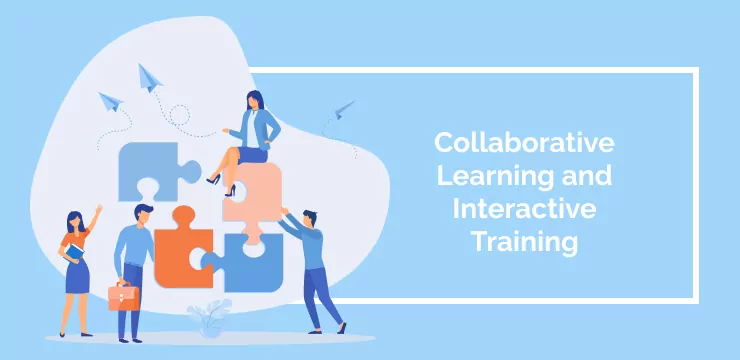
Collaboration helps people to learn in many ways.
Learners improve their understanding by sharing their problems and explaining challenging concepts.
Group discussions help staff to find inspiring solutions they would never have discovered on their own. And working together improves morale— keeping staff motivated when the material is complex.
Collaborative learning solutions can also be interactive, engaging learners through all their senses. This is a great employee training method for staff in technical or creative roles, as it can help them to enhance their skills in a way that feels more like play than work.
Collaborative learning can be most effective when employees use problem-solving skills to help their businesses.
Video Conference Training
Video conferencing can be an effective employee training method for remote teams and organizations, allowing staff to share their knowledge and skills conveniently and flexibly.
As more businesses adopt remote work models, video conference training will become an essential employee training method for many organizations.
With video conference training, you get many of the same benefits as in-person training. The challenge is that even over live video, engagement levels tend to be lower.
Case Studies
Case studies can offer similar outcomes to on-the-job training but with fewer risks.
Studying case studies allows employees to see how theory can meet with practice without the potential pitfalls of doing this in reality.
While online learning tools are a great employee training method, case studies offer valuable insights and practical advice that staff can practice immediately.
This is a common approach to employee training in legal and medical industries.
Gamification of Learning
Games are a great way to improve employee engagement in the learning process.
Learning can be gamified when game-like tasks are included in learning materials— such as a quiz, a rewards system, or a league table for the cohort’s results.
Gamification is an add-on to other learning methodologies, inputting a bit of fun into otherwise monotonous activities.
There are many ways to introduce gaming features to learning – the only limit is the instructor’s creativity.
Lectures
Lectures are a form of traditional classroom training— and it’s easy to be critical of them. This is not a form of interactive training, and poorly done lectures can switch the whole audience off.
However, lectures can be a powerful employee training method when delivered effectively.
They offer the opportunity to share knowledge and expertise in an organized way and can be highly engaging when well-structured.
In particular, lectures are an excellent employee training method for those who prefer to learn at their own pace.
They allow employees to use the time they spend in training to pause and reflect on new information, allowing them to fully absorb it and understand the context.
Blended Learning
Blended learning occurs when two or more training methods are combined to reach one common goal.
This is not a strict methodology but offers a great way to balance independent and instructor-led training.
Usually, blended learning will offer face-to-face interactive training and online education.
Employees can continue their learning process at their own pace for some elements. In other aspects, instructors can provide detailed instruction, answer questions, and give detailed learner-specific feedback.
Management-orientated Training
Potential managers need well-tailored training to ensure they can succeed in transitioning from operative to managerial roles..
Sometimes, management-oriented training can focus on critical technical skills that managers need to get right. That might be around performance management, end-of-period reporting, or niche digital skills that most staff don’t need to worry about.
But employee training methods may also focus on broader leadership skills and team development.
This is an important area for potential managers to develop, as it will help them to understand employee motivation and build strong teams.
Alternatively, it might be about soft skills, including some real application through job shadowing, role-playing, or case studies.
Cultural Training
This is about educating employees about the culture and values of the workplace.
If you want your employees to understand the importance of trust, empathy, and compassion, you can’t achieve that through another PowerPoint presentation.
Cultural training often includes elements of team building. The goal is to unify the workforce under a shared set of values.
Cultural training often occurs on “away days” or even social events. How you conduct a Christmas party can serve as a form of cultural training.
Choosing the right employee training method

When it comes down to brass tacks, you’re the one who will need to choose which training methods to use.
Mapping out your learning objectives is a critical step in choosing the right method. Ask yourself:
- What do I want my employees to take away from this training?
- How important is the content? (be honest)
- Do they want to know? Or do they need to know? (again, be honest)
Highly driven and engaged employees will flourish with coaching or mentoring and will get more out of 1-on-1 training.
Disenfranchised employees won’t do so well, but you still need to deliver training to them, so your goal should be to do so in the most convenient way possible.
Understanding the employee experience is essential if you tailor training methods for maximum effectiveness.
After all, happy, engaged employees want to learn— they just need you to give them the tools they need and get out of the way.
WalkMe Team
WalkMe spearheaded the Digital Adoption Platform (DAP) for associations to use the maximum capacity of their advanced resources. Utilizing man-made consciousness, AI, and context-oriented direction, WalkMe adds a powerful UI layer to raise the computerized proficiency, everything being equal.


